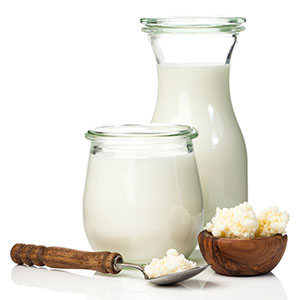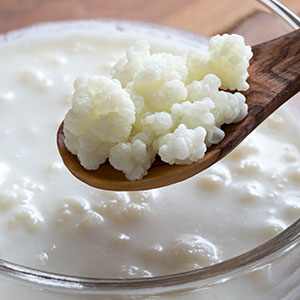Sleek bottles with elegant labels are claiming more and more space on the shelves of supermarket dairy sections, a response to the heightened passion for foods with healthy attributes. Many are not aware that kefir, though generally presented in thoroughly modern attire, has hundreds of years of street cred. This healthful elixir is on the lips of those seeking a nutritious beverage option.
Kefir is a fermented milk drink that delivers a creamy feel and tangy kick on the tongue. With a consistency similar to a drinkable yogurt, kefir is consumed for its flavor as well as for its probiotic benefits. Kefir grains — resembling small, gelatinous cauliflower florets — steep healthful bacteria and yeast into milk during the fermentation process. Cow’s milk is the most frequent base, particularly for commercial products, but at least one U.S. creamery offers a goat milk variety sold in grocery stores. Like other dairy products, kefir is available in formulations including whole milk, organic, low-fat, nonfat and lactose-free.

Where It Begins
Given its long-ago origin — dating back at least 2,000 years by most accounts — kefir has a history with several different tellings, all of them colorful.
Most agree the drink originated in the Caucasus Mountains, which divide Asia and Europe, where goatskin bags containing milk and kefir grains were hung where they could be agitated as people walked by. Given the transformation of goat or cow milk into such a tangy, slightly fizzy beverage, it’s no wonder there’s a theory of divine provenance. Babushka, the Sydney, Australia-based producer of traditional and artisanal kefir, shares one such story: “The grains of kefir were considered a gift from God among the common folk and it is said the grains were blessed by the prophet Mohammed himself. The secret of the kefir grains, passed down from generation to generation, was considered a source of family and tribal wealth.”
The modern day chapter of kefir history shifts to Russia at the turn of the 20th century, where production began using grains reportedly obtained from a prince in the Caucasus Mountains. As this story goes, the prince (dastardly and, at least by today’s standards, criminal) abducted a kefir-seeking emissary in the hopes of marrying her. Thwarted, he was ordered to make amends through a sizable gift of kefir grains. Today, Russia produces more kefir than any other country and is cited by many lexica as the source of the word “kefir,” thought to be derived from either the Turkish word “keyif,” meaning “good health, ” or “köpür,” meaning froth or foam. The most common pronunciations are keh-FEAR and KEE-fer.
The grains, which multiply through the fermenting process, are still shared among family members and friends who make kefir at home. “You can eat the grains or give them to friends so they can make kefir,” says a spokesperson for Cultures for Health, which has been selling do-it-yourself kits on its website since 2016. “Some home fermenters will even toss extra grains in with their vegetable ferments.”

Kefir Culture
Today, companies making kefir for commercial sale use starter cultures to deliver a consistent quality and assure shelf stability.
“There are two or three culture houses that are producing these blends,” says Jennifer Bice, managing director of the Sonoma County, CA-based Green Valley Organics and Redwood Hill Farm. “When we started out with our yogurt or kefir, we got various samples of different blends. We basically did different experiments, and research and development. The ones we selected we thought had the most unique and delicious flavor development, while also still retaining high levels of probiotics, which we verified through testing. It’s kind of like the cook in the kitchen. I selected products that appeal to my taste buds. Over the years, other people have liked them, as well.”
Alexi Milaras, director of Babushka, says he and his father George, the company’s co-founder, began making kefir at home to provide holistic support to his mother who was undergoing treatment for cancer. As they moved to commercial production, they selected a starter culture of freeze-dried kefir grains. “They come in little sealed envelopes, and it is a yellowy, fine powder that ‘dissolves’ in the milk. The factory that we purchase from grows kefir grains in perfectly monitored labs, takes the grains and freeze dries them, then packages them,” says Alexi Milaras.
“All the different kefirs and yogurts can use different strains and combinations of cultures,” explains Bice. “Just because it’s kefir doesn’t mean every kefir on the market uses the same exact culture.” Green Valley’s lactose-free kefir and Redwood Hill Farm’s goat milk kefir are made with a blend of 11 live and active cultures, all listed on the product labels, as with all kefir companies.
With starter culture in hand, fermentation can begin. Milaras describes the process: “Once your milk is pasteurized (this is an Australian food standards law requirement), you cool the milk to a fermentation temperature between 18 and 26 degrees C or about 64 to 79 degrees F, add your starter culture or kefir grains and stir to get it to mix. Turn off the stirrer and let it sit at that temperature for a minimum of 18 hours.”
“It is very much like yogurt,” he says. “The biggest difference would be the temperature in which you add your culture to ferment and how long you ferment it for.”

Serving Suggestions
Kefir is most commonly consumed just as purchased (or made at home) — as a beverage that comes plain or in a wide variety of flavors, many of them fruit-based. Green Valley and Redwood Hill offer a blueberry-pomegranate-acai flavor in both cow and goat milk. Babushka’s line includes a coconut-flavored kefir.
Lifeway Foods, based in Morton Grove, IL, one of the largest kefir manufacturers in the United States, offers a broad range of products and flavors, including some with a seasonal flair, like pumpkin spice and cranberry crème brulee. Other well-known kefir companies include Wallaby and The Greek Gods.
There are limitless ways to add kefir to one’s diet, but the most simple is as a milk substitute. “The best way to drink it is as part of your lifestyle,” says Babushka’s Milaras. “Use kefir in a smoothie instead of yogurt or milk.” Kefir producers feature recipes and tips on their websites, and there are cookbooks available for deeper exploration. Lifeway’s chief executive Julie Smolyansky has written The Kefir Cookbook, which includes 100 recipes and joins other books offering kefir inspiration, like Traditionally Fermented Foods by Shannon Stronger. Stronger’s creations include Kefir Buckwheat Muesli with Figs and Ginger, and German Sweet Potato-Kefir Mash.
Bice says customers often tell her they incorporate kefir into smoothies, salad dressings and dips. “It’s a great buttermilk substitute for pancakes,” she says, but notes that kefir’s beneficial bacteria lose their effect when heated.
Kefir is also marketed in cups, like yogurt, made into cheese and transformed into frozen desserts.
About Those Probiotics
Like most dairy, kefir is a good source of protein, calcium and Vitamin D. But kefir stands out for its wealth of beneficial probiotic bacteria, which research says can support gut health and strengthen immunity.
“A growing body of scientific studies points to ways that probiotics can benefit human health,” the International Scientific Association for Probiotics and Prebiotics writes in Probiotics: A Consumer Guide for Making Smart Choices. “Probiotics can support digestive health and/or immune function. This includes reducing antibiotic- associated diarrhea, helping manage digestive symptoms, improving your ability to fight off colds, promoting healthy vaginal and urinary tracts, and improving digestion of lactose. Promising targets in initial stages of research include glycemic and weight control and brain function.”
There is no prescription, of course, but Bice says customers tell her drinking a cup of kefir a day helps keep their digestion on track. “You need to be eating probiotic-rich foods on kind of a daily basis,” she says. “They don’t last that long in your system. You can’t just eat them once a week and think you’re getting the benefits.”
Milaras says some consumers mistakenly perceive kefir as medicine, a tonic for what ails them. “I don’t want to imply that it doesn’t have medicinal value to it, but it’s not a cure-all,” he says. “The evidence suggests fermented products are good for your health, good for your gut. They can help your immunity. Kefir can help … but it’s not a cure-all. It’s a lifestyle approach that can help keep you healthier.”



